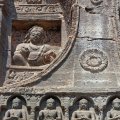AJANTA CAVES (CAVES OF AJANTA)
30 Buddhist caves, 4 of which are sanctuaries, carved out of the rock overhanging a meander in the Waghore River
Carved out of the rock, the 30 Buddhist caves of Ajanta overlook a meander of the Waghore River. Dating from the 2nd century BC to the 6th century AD, these caves are a unique, fragile and precious testimony to religious fervour in ancient India. They are listed as a UNESCO World Heritage Site. Ajanta's reputation stems from the incredible state of preservation of its frescoes, created using the "tempera" technique, an emulsion obtained by mixing natural pigments and a binder. Here, it would appear that vegetable gums have been combined with glues of animal origin.
The caves are numbered from 1 to 30, in order of progress. Some are closed to the public or inaccessible (nos. 3, 5, 8, 22 and 30). Four caves are sanctuaries (nos. 9, 10, 26 and 29), or chaitya, containing a stupa. The others are monastic dwellings or vihara. Obliged to travel, Buddhist monks took up permanent residence during the monsoon season. It would seem that it was during these long rainy months that they were busy decorating the caves.
The best time to visit is early morning. In order to preserve this priceless heritage, special lighting has been installed so as not to alter the pigments. To admire some of the frescoes in detail, a flashlight may prove useful. Flashbulbs are not permitted.
Caveno. 1: this first cave is the most recent. Archaeologists believe it was never inaugurated, as they found no traces of soot at the foot of the Buddha statue, as devotees used to light oil lamps that left indelible marks. The magnificently ornamented façade is the finest in Ajanta. Scenes on the façade depict the life of Buddha, while other elements are purely decorative. The cave was a vihara, and the cells were located on the sides of the entrance. The main hall is 12 meters long. It is supported by 12 pillars that hold up the beautifully painted ceiling. The 6-meter-high walls are adorned with partially visible frescoes depicting scenes from the Jataka, a tale that recounts the lives of Gautama Buddha in human and animal form. The back wall features a shrine with a large Buddha statue. Don't miss the giant portraits of the bodhisattvas Padmapani and Vajrapani on either side of the door, watching over the idol. These are Ajanta's most famous paintings.
Caveno. 2: Identical in appearance to caveno. 1, the details reveal that they are not from the same period. The pillars are more massive and the sculptures on the entrance porch are very different in execution. With the exception of the floor, this cave was entirely painted. Although not intact, the frescoes are in a better state of preservation than in the first cave. Note the presence of numerous female figures, extracts from the Jataka and a fresco showing children studying, those in the front row being concentrated while those behind appear more dissipated. The major sculpture is that of the goddess Hariti. Born a demon, she was known to transmit chickenpox and eat children. Buddha converted her and made her the guardian of fertility and protector of infants.
Grottono. 4: this is the largest of Ajanta's monasteries, unfortunately unfinished. The date of its excavation is uncertain, but the Department of Archaeology puts it in the 6th century. It consists of a veranda, a hypostyle chamber and a sanctuary preceded by an antechamber. An imposing image of Buddha preaching stands inside the sanctuary, where he is surrounded by bodhisattvas and nymphs. The fresco on the veranda's inner wall depicts the Litany of Avalokitesvara. This bodhisattva represents compassion.
Caves 9 & 10: these two caves are chaitya, or prayer and meditation halls. Cave 10 is thought to date from the 1st century BC, and cave 9 from the 1st century. Semicircular in shape, the chaitya features a ribbed ceiling supported by columns close to the walls. At the far end of the cave is a stupa representing the Buddha spirit. The walls of cave no. 10 were entirely painted, and fragments can still be seen. Later, Buddha statuettes donated by devotees were placed on the walls. There are said to have been 300 of these, many of which have now disappeared.
Grottono. 17: Two majestic elephants greet you at the entrance. This cave was apparently funded by Hindu Prime Minister Varahadev and local King Upendragupta, as inscriptions testify. It is in this cave that the paintings are best preserved. These include numerous representations of Buddha, as well as frescoes telling the story of Gupta and Udayin, Nalagiri and excerpts from the Jataka.
Grottono. 26: The most striking feature of this grotto is the superb reclining Buddha sculpture to the left of the entrance. The walls are adorned with fine carvings depicting Buddhist legends. Remains of paintings can still be seen in some parts of the cave, notably on the pillars. In the center, an imposing stupa is carved into the rock.
Did you know? This review was written by our professional authors.
Book the Best Activities with Get Your Guide
Members' reviews on AJANTA CAVES (CAVES OF AJANTA)
The ratings and reviews below reflect the subjective opinions of members and not the opinion of The Little Witty.

